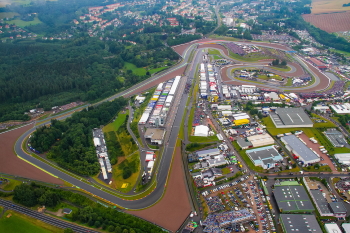Its varied history makes the Sachsenring attractive, even after all those years. It survived all political eras and managed to come out of each one the stronger for it. And on this year’s anniversary, the Sachsenring has quite a story to tell. It all began on 26 May 1927 – a historical date.
That’s when the first motorcycle race was started here, at the time it was still called the Badberg- Viereck race. Over than 140,000 spectators lined the track. During
the second run the following year there were a few injuries and several fatal accidents. As a result, the races were prohibited.
It wasn’t until 1934 that organisers
dared to try it again. At first there were still some nay-sayers as the two-wheelers rode at high speeds around Hohenstein-Ernstthal but it wasn’t long before the “Sachsenring”,
named in 1937, became something nobody could imagine living without. On the contrary. The course continued to get more and more well-known and quickly became a part of the
international racing calendar. In 1936 and 1938 the “Große Preis von Europa” [European Grand Prix], comparable to today’s World Championships, was run on this track. The racing
distance was 40 laps for the 500s. That was about 350 kilometres. It took drivers two and a half hours to cover that distance.
The heros from that pre-war time were Ewald
Kluge, Georg Meier, James Guthrie and Bernd Rosemeyer. They made history on the 8.7 kilometre natural racetrack. Then the war came. The region lay in ruins. But as soon as it was
over the motorcycles were quick to start up again. Spectators showed up at the Ring in droves again as early as 1949. In 1950 the Sachsenring reached its absolute peak with 480,000
guests on racing Sunday alone.
The constant presence of even top international drivers wasn’t without consequences. From 1961 to 1972 the big names on the scene rolled
in with the world championship support staff one after the other: Giacomo Agostini, Mike Hailwood, Angel Nieto, Dieter Braun. The Sachsenring had done it: World Championship races
were held in the solo categories. “Ago” went down in history in this World Championship era with the fastest race lap ever. He did it in 2:55.4 minutes. That’s an average of
176.798 km/h. For Dieter Braun the races were always something very special. The two-time world champion and 14 time Grand Prix winner still remembers exactly how things were: “I
rode my best race in 1971 at the Ring.” The Swabian won in front of a stunning backdrop of 300,000 spectators in the 250 category, leaving champions like Rod Gould and Phil Read
far behind. “It was huge. We West Germans were worshipped as heroes at the time of the Iron Curtain.”

1973 was the end of that. The government of the GDR only held races with participants
from the Eastern states. Western drivers were no longer permitted. It wasn’t until 1990 that everyone was allowed to race again. But for the time being it was the last year before
a break. City transit no longer permitted this kind of competition. The Ring passed right through the town of Hohenstein-Ernstthal. That had always given the race a really special
flair but during the previous season there had been three deaths.
But a Sachsenring without a race? First there was a bold plan to build a motodrome but it failed.
That’s why ADAC Saxony detoured to Most and Brno as a last resort, in hopes of seeing the tradition of the Sachsenring race live on.
But the construction of a traffic
safety centre at the Sachsenring in 1995 opened up completely new possibilities. Following some rebuilding in 1996, it can still be made into a racing track for cars and motorcycles
if necessary. The “new” Sachsenring still contains parts of the old course but it has been expanded in keeping with the highest safety standards and no longer affects the public
transportation system. The present facility has a permanent and contemporary pit lane facilities, a new start/finish tower, one of the most state-of-the-art race control centres ever.
In light of these conditions, the Grand Prix circus returned to the historic site in 1998. A new press centre was constructed for the international press. The asphalt on the
Sachsenring was completely redone last year, making it a modern racetrack, in keeping with Grand Prix sport standards for years to come. The MotoGP races at the Sachsenring have since
acquired a legendary reputation. Over 220,000 spectators attended the most recent mega event.
The Free State of Saxony, ADAC and a special Sachsenring association invest
huge amounts to keep the motor sport events and working conditions up to date.
Further InformationWikipedia
Racing Circuit Info
Under Construction.
Courtesy:Under Construction.
Courtesy: